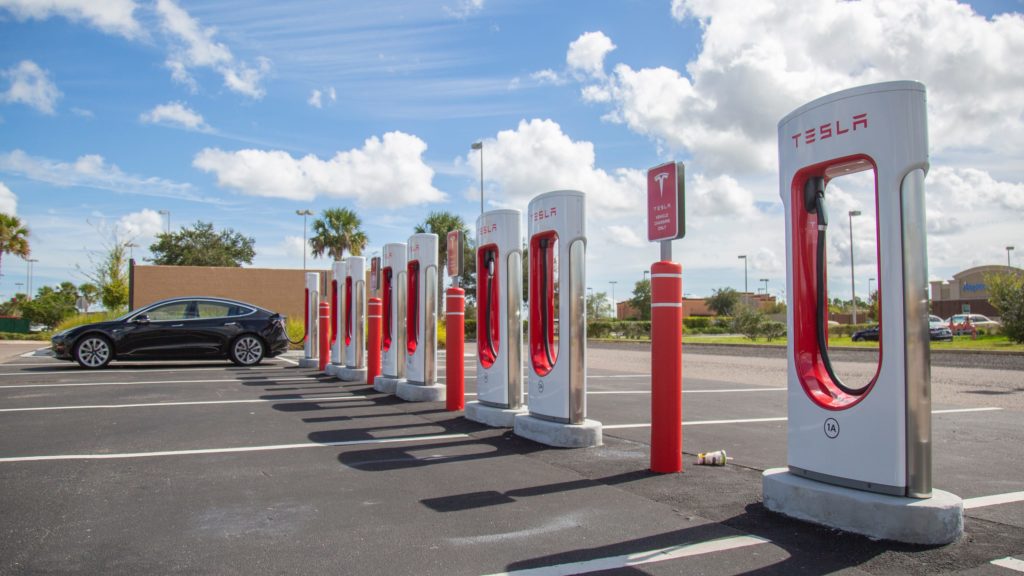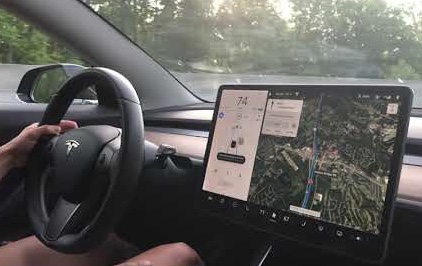Since purchasing my Model 3 Tesla earlier this year, I’ve been really eager to take her out on a longish trip. We’re talking a trip that requires at least one -possibly more- use of Tesla’s Superchargers.
However, month after month passed and there simply was no point at which I could do such a longish trip. That is, until the past week.
My youngest daughter, heading back to her University in North Florida, needed some help taking stuff up there and it proved a perfect time to test the ability of my Model 3’s long range trip along with the navigational computer.
The later proved to be a dream: You tap the Navigation button, put in the address to where you’re going, and the Navigational computer not only gives you the trip laid out, it tells you where to go to charge your vehicle once it gets low of charge.
That turned out to be almost exactly half-way from home to North Florida, in the West Melbourne area…

I have to admit, I was nervous. The trip estimated I would have but 15% of charge left in the car once arriving at West Melbourne, a very small amount of miles (in the neighborhood of 50-60) left within the vehicle.
As I drove, I realized it was true what they say about Tesla’s: They use up far less charge when in stop/start city traffic and are able to use their “regenerative” braking, which allows the car to create small electric charges as the car stops itself. On the highway the vehicle’s electric charge goes away much quicker as you’re using pure charge with your movement and no/little regenerative braking.
And the faster you go, the more charge is used up.
So as I was driving a few miles ahead of my daughter, I was watching the range go down and down and down and, because it was the very first time I did this, I was indeed worried about the range and how close to empty I’d be once I got to West Melbourne.
Welp, as it turned out I didn’t have much to worry about at all.
The Navigation system measured the progress of the car as it moved along, giving me a very accurate estimate of what time we’d arrive at the charger as well as a mile by mile countdown to that arrival. The Navigator also showed me the exit number and, on the map in the Model 3’s central panel, my path.
The above photograph is not from my vehicle but it could easily be. This is the standard Model 3 interior, very sparse (I happen to like this, though others do not) and all your information is presented on that central screen. In the large area that covers roughly 3/4ths of the monitor, you see a Google Map which displays where your car is and, if you’ve entered a Navigation destination, a nice clear blue line shows your path to your destination.
Anyhow, getting to West Melbourne was fine. How was using the Supercharger?
It was fine as well but here is something that gas powered vehicles have an advantage over the Tesla electric vehicle: To recharge my car to 80% (which is where I usually charge it to), required roughly 30 minutes. If you’re filling a gas tank, obviously, this requires usually not more than 10 minutes, if that.
We were in a bit of a rush because my daughter was taking her two pet cats and didn’t want to stay too long, so we charged for a little less than the full half hour and arrived in North Florida with something like 40 miles left in my “tank”.
Again I was nervous about the range but, again, it turned out I didn’t have to be. The car knows how far it can go and, looking around online, I discovered if you’re approaching the point where you might reach 0, the car suggests your speed (the lower, the less you use) and/or a closer Supercharger to use.
In North Florida and some ten minutes max away from my daughter’s apartment is another Tesla Supercharger so after unpacking everything, I headed to it and in some 40 minutes (again, the car was very low) I had the car fully charged.
We used it for the few days we were up there and the day before the wife and I returned home we charged it up to 80% and the next morning were off.
The trip back turned out to be exactly the same as the trip up, only in reverse. We again stopped at the West Melbourne Supercharger station but this time around we weren’t in a huge rush to leave. The Supercharger is in a nice mall area and we were able to take a bathroom break and get ourselves a sandwich then eat it in the car while it was charging.
Once done, it was off again, using the car’s autopilot feature to essentially drive us back home. When we got there, I pulled out my charging cables and with the much slower 240V charger at my house got the car charged overnight (nearly 7 hours of charging versus 30-40 minutes) and was able to use the car the next day to head out to work.
My ultimate impression of the trip was very positive. Yeah, it takes a little longer to charge your car versus pouring gas in it, but Tesla is already at work with their version 3 of the Supercharger and I suspect it’ll soon make its way to all Superchargers. If nothing else, this company is looking at making all aspects of driving an electric car at the very least compatible if not much better than using a gas powered car.
I know there are many out there who hate Teslas. In part, it might be related to antipathy toward Elon Musk, but as I’ve said many times before: You can hate the man but you can’t argue with the technology and the car itself.
I’m still very early into owning a Tesla/electric vehicle but I remain very impressed with it. Yeah, the range isn’t quite up there with gas powered vehicles. My daughter’s Mazda can make the trip on one gas tank -though she’ll be running on the proverbial “fumes”- versus my Tesla which will not reach that distance and does require a charge about halfway up the coast.
However, this is the only thing that I find superior about using a gas car versus a Tesla, and given the distance and need to stop for a bathroom break/food, it really isn’t that big an inconvenience to stop for about 30 minutes for a quick charge.
Here’s the thing, though: These Superchargers work only with the Tesla vehicles. I can’t help but wonder how other electric vehicles operate on long distance trips like this. First, I know that almost all of them do NOT have the range of Teslas. Further, the charging stations that are available -and there are many of them- likely don’t charge quite as quickly as the Tesla Superchargers do.
Are they comparable?
I dunno. I suppose I could do a Google search and figure it out, but my interest is in my Tesla and I couldn’t be happier.
Until the next time we take a longish trip!

